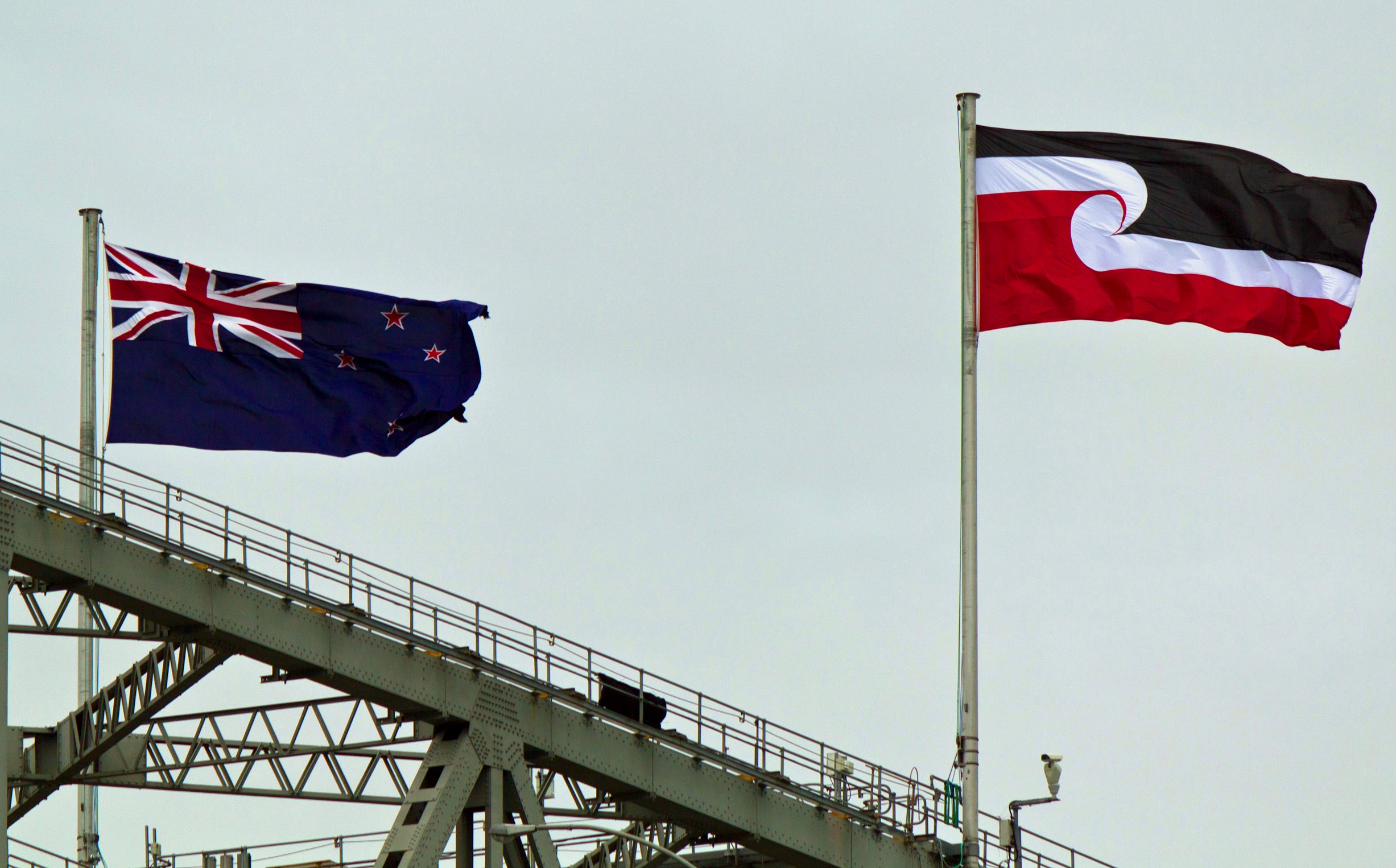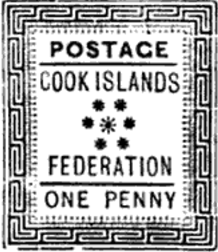|
Flag Of The Cook Islands
The flag of the Cook Islands, officially known as the Cook Islands Ensign, is based on the traditional design for former British colonies in the Pacific region. It is a blue ensign containing the Union Flag in the upper left, and on the right, fifteen stars in a ring. The Union Flag is symbolic of the nation's historic ties to the United Kingdom and to the Commonwealth of Nations. The stars stand for the fifteen islands that make up the Cook Islands ( Tongareva, Rakahanga, Manihiki, Pukapuka, Nassau, Suwarrow, Palmerston, Aitutaki, Manuae, Takutea, Atiu, Mitiaro, Mauke, Rarotonga and Mangaia). The blue represents the ocean and the peaceful nature of the inhabitants. History A Federal Flag Bill was proposed in the Cook Islands Parliament in 1892, but was not assented to. The proposed flag had consisted of three horizontal stripes (red, white, red), with a Union Flag in the top left corner, overlaid by a black coconut palm tree on a white circle. [...More Info...] [...Related Items...] OR: [Wikipedia] [Google] [Baidu] |
Cook Islands Dancers At Auckland's Pacifica Festival 2
Cook or The Cook may refer to: Food preparation * Cooking, the preparation of food * Cook (domestic worker), a household staff member who prepares food * Cook (professional), an individual who prepares food for consumption in the food industry * Chef, a professional proficient in all aspects of food preparation Geography U.S. * Cook, Minnesota, a city * Cook, Nebraska, a village * Cook, Ohio, an unincorporated community * Cook Hill (other) * Cook Hollow, Oregon County, Missouri * Cook Inlet, off the Gulf of Alaska Australia * Cook, South Australia * Cook County, New South Wales * Cook, Australian Capital Territory Elsewhere * Cook Peninsula, Nunavut, Canada * Cook Strait, the strait separating the North and South Islands of New Zealand Companies * Cook Group, an American manufacturer of medical devices * Cook Records, an American record label * Cook Trading, a UK manufacturer and retailer of frozen ready meals * Thomas Cook Group, a defunct British travel company Fi ... [...More Info...] [...Related Items...] OR: [Wikipedia] [Google] [Baidu] |
Takutea
Takutea is a small uninhabited island in the Cook Islands, north-west of Atiu. Administratively, the island is considered part of Atiu, the closest island. It is owned equally by all inhabitants of Atiu and not allocated to one specific village or district of Atiu. Geography Takutea is an oval island roughly long and 3/4 of a mile across. It consists entirely of sand, with a maximum elevation of . The island is surrounded by a narrow reef. History Takutea has never been permanently inhabited. It was originally called ''Areuna'', but was renamed ''Taka-ku-tea'' ("my white ku") by the explorer Mariri after he caught a white ''ku'' (squirrelfish) there. The island was also known as ''Enua-iti'' ("Small Island"). Takutea was visited by the people of Atiu, who collected seabirds and coconuts there and regarded it as tribal land. When Captain James Cook sighted the island on 4 April 1777, and some crew members went ashore, they found some huts, but no evidence of a permanent settl ... [...More Info...] [...Related Items...] OR: [Wikipedia] [Google] [Baidu] |
Blue Ensigns
Blue is one of the three primary colours in the RYB colour model (traditional colour theory), as well as in the RGB (additive) colour model. It lies between violet and cyan on the spectrum of visible light. The eye perceives blue when observing light with a dominant wavelength between approximately 450 and 495 nanometres. Most blues contain a slight mixture of other colours; azure contains some green, while ultramarine contains some violet. The clear daytime sky and the deep sea appear blue because of an optical effect known as Rayleigh scattering. An optical effect called Tyndall effect explains blue eyes. Distant objects appear more blue because of another optical effect called aerial perspective. Blue has been an important colour in art and decoration since ancient times. The semi-precious stone lapis lazuli was used in ancient Egypt for jewellery and ornament and later, in the Renaissance, to make the pigment ultramarine, the most expensive of all pigments. In the eig ... [...More Info...] [...Related Items...] OR: [Wikipedia] [Google] [Baidu] |
National Flags
A national flag is a flag that represents and symbolizes a given nation. It is flown by the government of that nation, but usually can also be flown by its citizens. A national flag is typically designed with specific meanings for its colours and symbols, which may also be used separately from the flag as a symbol of the nation. The design of a national flag is sometimes altered after the occurrence of important historical events. The burning or destruction of a national flag is a greatly symbolic act. History Historically, flags originated as military standards, used as field signs. Throughout history, various examples of such proto-flags exist: the white cloth banners of the Zhou dynasty's armies in the 11th century BC, the ''vexillum'' standards flown by the armies of the Roman Empire, the Black Standard famously carried by Muhammad which later became the flag of the Abbasid Caliphate, and the various "Raven banners" flown by Viking chieftains. Angelino Dulcert publishe ... [...More Info...] [...Related Items...] OR: [Wikipedia] [Google] [Baidu] |
National Symbols Of The Cook Islands
National may refer to: Common uses * Nation or country ** Nationality – a ''national'' is a person who is subject to a nation, regardless of whether the person has full rights as a citizen Places in the United States * National, Maryland, census-designated place * National, Nevada, ghost town * National, Utah, ghost town * National, West Virginia, unincorporated community Commerce * National (brand), a brand name of electronic goods from Panasonic * National Benzole (or simply known as National), former petrol station chain in the UK, merged with BP * National Car Rental, an American rental car company * National Energy Systems, a former name of Eco Marine Power * National Entertainment Commission, a former name of the Media Rating Council * National Motor Vehicle Company, Indianapolis, Indiana, USA 1900-1924 * National Supermarkets, a defunct American grocery store chain * National String Instrument Corporation, a guitar company formed to manufacture the first resonator gui ... [...More Info...] [...Related Items...] OR: [Wikipedia] [Google] [Baidu] |
Flags Of Oceania
This is a gallery of national flags of Oceania. Flags of Oceanian sovereign states Flags of Oceanian dependencies and other territories Flags of Oceanian sub-divisions States of Australia Territories of Australia Associated states of New Zealand Components of the Federated States of Micronesia Components of French Polynesia States of the United States Flags of Oceanian cities Flags of cities with over 1 million inhabitants. Historical flags See also ; Lists of flags of Oceanian countries * List of Australian flags * List of Fijian flags * List of Nauruan flags * List of New Zealand flags * List of Palauan flags * List of Papua New Guinean flags * List of Samoan flags * List of Vanuatuan flags Notes References {{DEFAULTSORT:Flags Of Oceania Oceania Oceania (, , ) is a region, geographical region that includes Australasia, Melanesia, Micronesia, and Polynesia. Spanning the Eastern Hemisphere, Eastern and Wester ... [...More Info...] [...Related Items...] OR: [Wikipedia] [Google] [Baidu] |
List Of New Zealand Flags ...
This is a list of flags of New Zealand. It includes flags that either have been in use or are currently used by institutions, local authorities, or the government of New Zealand. Some flags have historical or cultural (e.g. Māori culture) significance. National flags Royal and viceregal Ensigns Associated states and territories Regions and cities Māori flags Sporting flags Other New Zealand flags Proposed alternative flags Notes References Further reading * External links * {{Lists of flags New Zealand Flags A flag is a piece of textile, fabric (most often rectangular or quadrilateral) with a distinctive design and colours. It is used as a symbol, a signalling device, or for decoration. The term ''flag'' is also used to refer to the graphic desi ... [...More Info...] [...Related Items...] OR: [Wikipedia] [Google] [Baidu] |
Cook Islands Federation
__NOTOC__ The Cook Islands Federation was created in 1891, after the Kingdom of Rarotonga was given the island of Aitutaki. It lasted until 1901, when it was given to New Zealand. Geography The Cook Islands Federation was made up of the islands of Rarotonga, Mangaia, Atiu, Mauke, Mitiaro and Aitutaki. Economy Law The laws of the Cook Islands Federation were made by the local parliament, however, they had to receive approval from a Resident from Britain. In 1899, the Parliament of Cook Islands ruled that the high court of the Cook Islands Federation could not give any punishment worse than those outlined by the Criminal Code Act of 1893, and The Summary Jurisdiction Act of 1894, which were both laws of New Zealand, and that both acts of New Zealand were to be adopted entirely. Penal colonies In 1892, the island of Takutea was set up as a penal colony, but in 1899 its use ceased, and the island of Manuae was used instead. See also *History of the Cook Islands The Cook Is ... [...More Info...] [...Related Items...] OR: [Wikipedia] [Google] [Baidu] |
Kingdom Of Rarotonga
The Kingdom of Rarotonga, ( rar, Mātāmuatanga Rarotonga) named after the island of Rarotonga, was an independent kingdom established in the present-day Cook Islands in 1858. In 1888 it became a protectorate of the United Kingdom by its own request. In 1893 the name was changed to the Cook Islands Federation. Establishment After the early conversion of a number of important (high chiefs) support for increased rapidly throughout the |
Mangaia
Mangaia (traditionally known as A'ua'u Enua, which means ''terraced'') is the most southerly of the Cook Islands and the second largest, after Rarotonga. It is a roughly circular island, with an area of , from Rarotonga. Originally heavily populated, Mangaia's population has dropped by 75% in the last 50 years. Geography Originally known as ''A'ua'u'' or ''A'ua'u Enua'' ("terraced"), the island was named Mangaia (or ''Mangaianui-Neneva'', "Mangaia monstrously-great") by Tamaeu, who came to the island from Aitutaki in 1775. Geologists estimate the island is at least 18 million years old. It rises 4750 m (15,600 ft) above the ocean floor and has a land area of 51.8 km2. Surrounded by a fringing coral reef, like many of the southern Cook Islands, it is surrounded by a high ring of cliffs of fossil coral 60 m (200 ft) high, known as the makatea. The inner rim of the ''makatea'' forms a steep cliff, surrounding swamps and a central volcanic plateau. The interi ... [...More Info...] [...Related Items...] OR: [Wikipedia] [Google] [Baidu] |
Rarotonga
Rarotonga is the largest and most populous of the Cook Islands. The island is volcanic, with an area of , and is home to almost 75% of the country's population, with 13,007 of a total population of 17,434. The Cook Islands' Parliament buildings and Rarotonga International Airport, international airport are on Rarotonga. Rarotonga is a very popular tourist destination with many resorts, hotels and motels. The chief town, Avarua, on the north coast, is the capital of the Cook Islands. Captain John Dibbs, master of the colonial brig ''Endeavour'', is credited as the European discoverer on 25 July 1823, while transporting the missionary Reverend John Williams (missionary), John Williams. Geography Rarotonga is a kidney-shaped volcanic island, in circumference, and wide on its longest (east-west) axis. The island is the summit of an extinct Pliocene or Pleistocene volcano, which rises 5000 meters from the seafloor. The island was formed between 2.3 to 1.6 million years ago, with ... [...More Info...] [...Related Items...] OR: [Wikipedia] [Google] [Baidu] |





